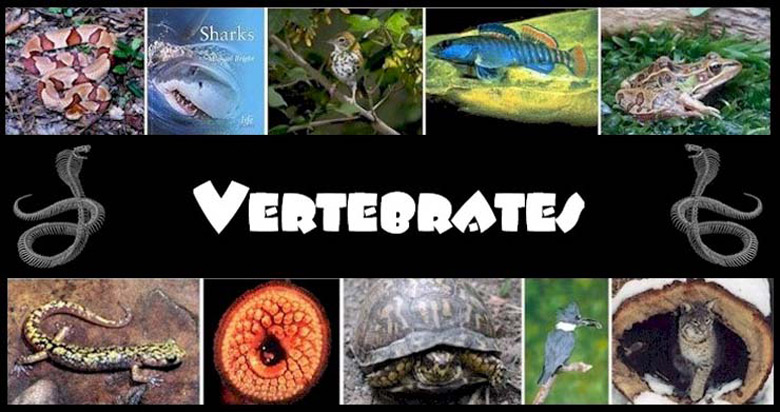What is a vertebrate?
Although not the most numerous group of animals in either number of individuals or in number of taxa, the vertebrates are an endlessly fascinating group of animals. Vertebrates are characterized by the vertebral column (backbone) that forms the main skeletal axis of the body.
Key Features of Vertebrates
- Skin of two divisions, including an outer epidermis and an inner dermis; the skin is often modified to produce hair, scales, feathers, glands, horn, etc.
- Bony or cartilaginous endoskeleton consisting of head and usually 2 pairs of appendages (arms and legs)
- movements provided by muscles attached to endoskeleton
- digestive system with large digestive glands, liver, and pancreas
- ventral heart with 2-4 chambers
- blood with red blood corpuscles containing hemoglobin
- paired kidneys with ducts to drain waste to exterior
- most vertebrates with two sexes, each with paired gonads (there are some exceptions)
- general body plan consisting of head, trunk, 2 pairs of appendages, and post anal tail (but these structures are highly modified in many vertebrates and sometimes absent).
Vertebrates are interesting partly because we are intimately familiar with them, but also because we ARE them. Our species, Homo sapiens, is included within the subphylum Vertebrata. Vertebrates are also interesting because they are easy to find. Many other groups of organisms cannot be seen with the naked eye or reside in places inhospitable to humans, like the sea floor. We coexist with many other vertebrates and are often quite aware of them in our environment. We also have many biological, social, cultural and historical ties with vertebrates. We have domesticated dogs, cats, and birds, and have used horses as a means of transportation. We have used carrier pigeons as a means of communicating over long distances. We also use many products from vertebrates, like cows for milk and leather or chickens for food.
Vertebrates have a long history on earth -- more than 500 million years, from the late Cambrian (543 to 490 mya) up to today. The first vertebrates lacked jaws, like the living hagfish and lampreys. Jawed vertebrates appeared 100 million years later, in the Silurian.
The vertebrates show affinities with other chordates but share some characteristics that make them unique. Vertebrates are found from the tropics to the polar regions, from the deep sea to high mountains, and even the air - vertebrates and insects being the only groups of animals to have mastered powered flight.
With rare exceptions, vertebrates have two separate sexes. Most lay eggs and are said to be oviparous, but a number of fishes and snakes retain their eggs in their bodies, and the eggs hatch internally. Such animals are called ovoviviparous. Many vertebrates, such as dogfish sharks and almost all mammals, have further modified the ancestral structures of the egg so that the embryo is not only retained inside the body of the female parent, but actively nourished through a special connection with the mother's body. This is known as being viviparous.
While vertebrates have a long and interesting history, humans are unfortunately helping to add to the list of organisms that no longer exist. These extinctions reduce the diversity of life on the planet and destroy our ability to understand all aspects of biology. There is great a diversity of vertebrates, both extinct and extant, that can help us understand a great deal about the forces that have shaped the Earth and help us predict and understand the future.
References
Maisey, J.G., et. al. 1996. The hall of vertebrate origins - A guide to fishes, amphibians, turtles, lizards, crocodiles, and pterosaurs. American Museum of Natural History, New York.
University of California at Berkeley - Introduction to the Vertebrates http://www.ucmp.berkeley.edu/vertebrates/vertintro.html
The University of Michigan - Museum of Zoology - Animal Diversity Web http://animaldiversity.ummz.umich.edu/vertebrata.html
Introduction to Evolution
http://evolution.berkeley.edu/evolibrary/article/evo_02
